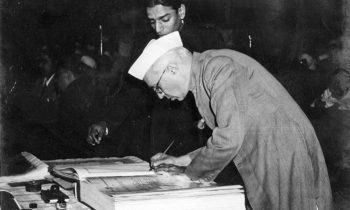Samir Chopra in Aeon:
 The United States and India, two of the world’s largest and oldest democracies, are both governed on the basis of written constitutions. One of the inspirations for the Constitution of India, drafted between 1947 and 1950, was the US Constitution. Both Indians and Americans revere their ‘constitutional rights’ – especially the ‘fundamental right’ of free speech, and the separation of state and religion. Both countries support critical traditions that focus on particular clauses of the constitution. In India, Article 356, which allows for the suspension of state legislative assemblies to permit ‘direct rule by the centre’, has provoked considerable critique, while in the US, the Second Amendment is a source of perpetual political and legal discord. The Indian and US supreme courts both enjoy the power of judicial review, to declare acts of other branches of government illegitimate, and so a measure of ‘supremacy’ over their respective legislative branches. For this reason, both constitutions are ‘undemocratic’ in their arrogation of too much political power to the judicial bench – a group of unelected public servants.
The United States and India, two of the world’s largest and oldest democracies, are both governed on the basis of written constitutions. One of the inspirations for the Constitution of India, drafted between 1947 and 1950, was the US Constitution. Both Indians and Americans revere their ‘constitutional rights’ – especially the ‘fundamental right’ of free speech, and the separation of state and religion. Both countries support critical traditions that focus on particular clauses of the constitution. In India, Article 356, which allows for the suspension of state legislative assemblies to permit ‘direct rule by the centre’, has provoked considerable critique, while in the US, the Second Amendment is a source of perpetual political and legal discord. The Indian and US supreme courts both enjoy the power of judicial review, to declare acts of other branches of government illegitimate, and so a measure of ‘supremacy’ over their respective legislative branches. For this reason, both constitutions are ‘undemocratic’ in their arrogation of too much political power to the judicial bench – a group of unelected public servants.
The US and Indian constitutions diverge in their ‘stability’ or ‘flexibility’. The US Constitution is very difficult to change and, thanks to a religious American sensibility that treats it as a sacral document, it has simply not evolved, impervious to the changing needs of a growing and progressing nation and world. The Constitution of India suffers from the converse flaw; in less than 75 years, it has been amended, at last count, 103 times.
More here.
